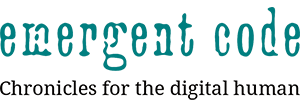
3.0 ‘Is’ and ‘Other’

The relationship we have with digital technology creates new boundaries of existence between our own inside world and world around us outside, between what is ‘us’ and what is ‘other’.
It is said there will be no lines between us and our devices in the future, and looking at the changing landscape of privacy, identity, social bonds and relationships online is the subject of this section.
There’s a wide range of decisions to make about the human self in relationship to the digital world, where it ends and we begin, as part of our relationship with code.
With a quarter of a century of the World Wide Web under our belts, we are perhaps ready to think about this question as part of the next chapter of our existence.
To dwell upon our own reflection in the digital world is to gaze at our emerging online selves, manifested in the phenomenon of the selfie. Sense-making and exploration of digital identity is an act of emerging digital self-awareness. The fascination is similar to that of a child’s catching a reflection of itself in a mirror for the very first time.
The selfie is also part of the narcissism of a ‘me’ culture. As we become digitally more atomised, online digital egos are perhaps a psychological compensation to deal with the insecurities that come from losing our roots and traditional senses of belonging to bedrock institutions of old. They are what define us.
Collectively, as part of developing a cognitive awareness about the emerging nature of digital humanity, some big themes are emerging around what it means to be digital, and how we deal with them through online behaviour.
They include the relationship of the ego to the self, between the digital psyche we project and who we actually are; how people develop their individual voice, the value of being seen and the right to be forgotten, of the winner-takes-all mindset of the elite, of sharing, of collective memory, empathy and the group mind.
This ‘Is and other’ section of Emergent code explores these themes. It considers how we might fashion a digital civilization out of a new level of human awareness about our digital selves. It is a take on who we are as a connected species and how we might deal with needy machines. It is about how we all have a piece of the answer and how we might organise as networks using data as a compass point to achieve our best possible futures.
What might we gain from developing digital civilization as humans in relationship to technology and to one another?
There will be many possible futures to consider and construct in the years ahead, based on the changing economic models that emerge from being digital. In a world of finite resources and frictionless connectivity, a more conscious relationship between the idea of what we are, our ‘is’ and what is ‘other’ might allow us to meet the needs we all have through co-existence in ways that are more mutually beneficial.
Understanding the relationship between ‘is’ and ‘others’ can make a positive, purposeful difference for us as an enhanced species as a result of code and interconnection.

One thought on “3.0 ‘Is’ and ‘Other’”
Comments are closed.